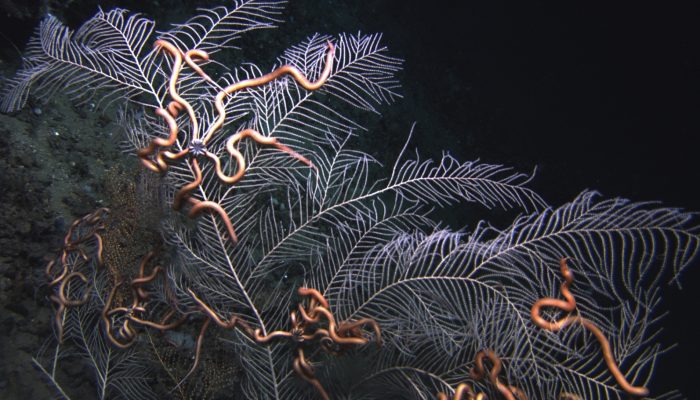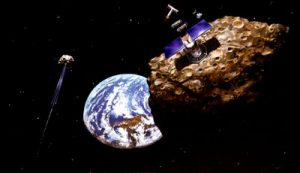
While climate change occupies the headlines as our biggest long-term concern for sustainability, there may well be further anthropogenic challenges that arise in the next century as we disrupt the delicate interplay of natural ecological and geological cycles to satisfy the need for resources of our ever-growing population. The mining industry makes for a pertinent example: it sits on the verge of new key locations for digging – from the deep ocean to deep space – the consequences of which may not be fully explored.
The shift to a low-carbon economy is likely to entail an increase in demand for a wide variety of minerals. A 2017 report from the World Bank highlights the growth in demand for Lithium, Platinum and Lead, for new battery technology and rare earth element demand for solar and wind technology is also likely to increase.
As demand for these metals and resources rises, the cost and difficulty of extracting them rises too. Millennia of mining have exhausted the easy-to-access deposits for most metals, and the ratio of exploration sites that turn into actual mines is in the order of 1 in 1000. Combined with a decline in the overall quality of ore that is mined, it’s not hard to see why mining industry strategists are looking to previously unusable locations for their new mining ventures.
Geologists have known for a long time that the sea floor contains extensive mineral deposits of a wide variety of types; from ferro-manganese nodules to ores linked to submarine volcanism, economic minerals are spread across the global ocean floor. Until recently, the economics of dredging these sea beds for minerals have not been favourable, and technology has been too rudimentary to make an effective industry out of this approach. Now, however, prices and demand for these minerals are high enough that seafloor mining is beginning to take place in a few locations around the world.
Extraction like this could, of course, have major consequences. Biodiversity in the deep ocean is, even today, poorly understood, so strip mining these systems before we explore them fully could cause untold damage. At a small scale, this kind of mining might only have more limited, local impacts, but for the first time in the history of human society we have the capability to affect biological systems and geological cycles at a global scale, to a degree that might have significant and deleterious effects.
For example, mining waste on land can lead to contamination of local water supplies with acidic runoff. Deep sea mining could similarly lead to acidification of sea water, which could have far reaching consequences. Marine creatures living in the ocean are often very finely tuned to the chemistry of the water they’re bathed in; even small changes in acidity have been linked to increased coral bleaching and death. The risk of heavy metal pollution has also been pointed out from sand and mud kicked up by mining activity as it disturbs the sea bed; these toxic metals could cause problems both the sea life and to humans, as the fishery stocks would become increasingly exposed to heavy metals. The global extent of ocean currents mean that these effects wouldn’t be limited to the vicinity of the mining, as chemicals would be mixed into the whole ocean over time.
Unlike mining on the surface, the spread of this kind of pollution could be truly global; ocean currents could eventually spread the pollutants, and the mining itself would hardly be limited to a specific locality. Humans are poorly positioned to deal with this kind of crisis; a negative impact on the ocean – a global resource, not owned by any individual nation state – is a classic ‘tragedy of the commons’, much like carbon dioxide accumulation in the atmosphere. Given the lack of ownership of the oceans, individual states or mining companies lack strong incentives to regulate the exploitation of such sea-floor resources. Moreover, the globalised nature of the extractive industry means this could be a truly significant impact; the combined revenue of the top 40 surface mining companies is approximately half a trillion dollars, dwarfing all but the largest national economies, affording such corporations major financial clout to explore and develop mining on the sea floor.
At the dawn of the fossil fuel era in the Industrial revolution, the risks of burning coal, and later oil and gas, were poorly understood in comparison to today. Some authors suggest that since we are now much more aware of environmental issues, we are better placed to assess the future risks and rewards of deep sea mining than the earlier resources for which we mined and drilled.
It is perhaps worth pointing out, though, that with the range out impacts still poorly constrained even as dredging begins, it is incumbent upon geologists to explore and quantify the potential risks; academic research must keep pace with the growth of industry.
Even if deep sea mining does not have major, long-lasting impacts, there is one other mining frontier for which the risks are nearly totally unconstrained: asteroids.
It may sound like science fiction, but serious consideration is being given to mineral resources on near Earth asteroids. Given their potential value (some estimates – of the asteroid Psyche suggest mineral resources worth a quintillion dollars – an amount of money that’s basically inconceivable), it’s not surprising that enterprising drillers are looking up, as well as to the sea floor. Again, though, research into the potential geological hazards needs to be undertaken well before such ventures are carried out.
Our ever increasing environmental footprint has the potential to spread to new and poorly studied horizons, and we should endeavour not to make the same mistakes as we did with fossil fuels.
Robert Emberson is a science writer, currently based in Vancouver, Canada. He can be contacted via Twitter (@RobertEmberson) or via his website (www.robertemberson.com).
**This article expresses the personal opinion of the author. These opinions may not reflect official policy positions of Geology for Global Development.**



